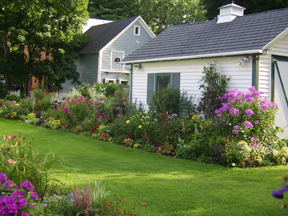If there is one ‘perennial’ question that I’m asked year after year, it is what’s the trick for creating non-stop color in the flower garden? Glad you asked!
Most gardeners are pleased with their spring and early summer gardens as there are plenty of blooms to delight the eye. The problem starts in August when summer heat takes its toll and the lack of later blooming perennials becomes all too noticeable. Yawn.
Why does this happen? Simple. Most flower lovers race to garden centers in spring, purchasing plants that are in full bloom or at least budding. We don’t even give a second glance to leafy, flowerless containers (that will shoot up glorious blooms later in the season). Our eyes are riveted on flowering specimens. By limiting our selection to flowering beauties, we have unknowingly created a garden that only looks great for about half of the growing season. In some ways, you can’t blame us. Living in the northeast, we are starved for color once the snow melts. The solution?
Restraint and delayed gratification. During spring shopping sprees, make sure to tuck some late blooming show-offs into your garden cart.
Some workhorses for sun to part sun that carry the baton into fall are:
Geranium ‘Rozanne’, Fleeceflower ‘Firetail’, Coreopsis ‘Moonbeam’, ‘Redshift’ and ,’Route 66’; Sedum ‘Autumn Joy, ‘Matrona’ and ‘Purple Prince’; Woods Light Asters; Joe Pye Weed; Giant Burnet (Sanguisorba) and of course, ornamental grasses.
Perennial shade or part shade lovers are fewer in number but include:
Yellow Waxbell (Kirengeshoma); Toad Lily; Eupatorium ‘Chocolate’; Bugbane (Cimicifuga) ‘Brunette’, ‘Hillside Black Beauty’ and ‘Chocoholic’, and Gentians. All of the above can be viewed online at Perennialresource.com.
Also take a scrutinizing look at your existing gardens. Think of a garden as having three ‘rows’. The row up front is for plants 1’ or less in height; the middle row is filled with medium sized plants (1’ – 3’ in height); and the back row houses the big boys; 3’ and taller. This way every ‘beaming’ flower can be appreciated just as children singing on tiered choir stands. Ideally, each ‘row’ should have a mix of spring, summer and fall blooming plants. Each ‘row’ doesn’t have to have an even number of each seasonal plant. I find that picking two seasons for peak flower color works best. For instance, 40% of my gardens are in bloom in spring; 40% in summer and 20% in fall. One of the toughest exercises for most gardeners is to ‘extract’ some existing plants to replace them with others that will provide better color and ideally be less maintenance. If it helps, remember, they’re not children.
As far as spacing, allow up to 12” apart for shorter plants; 15” – 18” for those in the middle row and 18” – 2’ for those in back.
Here are a few additional tricks to super-sizing, non-stop color in the garden:
- Play the foliage card. Foliage, unlike flowers, provides interest and drama three, if not four, seasons. Some perennial favorites are Coral Bells (‘Caramel’, ‘Peach Melba’, ‘Obsidian’, ‘Plum Pudding’, ‘Green Spice’); ornamental grasses; Ligularia ‘Britt Marie Crawford’ and others in this family; Lamiums (‘Pink Chablis’, ‘Beeham’s White’, ‘Anne Greenaway’); Hosta (of course); Heliopsis ‘Loraine Sunshine’; variegated Phlox paniculatas (‘Becky Towe’, ‘Norah Leigh’); blue leaved Dianthus (‘Frosty Fire’, ‘Firewitch’, ‘Blue Boy’); silver leaved plants (Artemisia ‘Silver Mound’, Lamb’s Ear, Snow-in-Summer); and Foam Flowers (‘Mint Chocolate’, ‘Black Snowflake’).
- Bulb it! Use spring, summer and fall blooming bulbs as fillers. I pack spring blooming bulbs (Tulips, Daffodils, Checkered Lilies, Trout Lilies, Camassia); summer blooming bulbs (Asiatic, Trumpet, Oriental, Orienpets) and fall blooming bulbs (Crocus and Colchicum) among perennials and shrubs for a riot of color.
- ‘Annualize’. Even low-maintenance gardeners rely on annuals to carry the ‘color baton’ May through October, especially in shade. A few well-placed annuals can unify gardens and ‘keep the light on’ when others around them have checked out. A few favorite, no-fuss winners for sun to part sun are Browallia, Alyssum ‘Snow Princess’, Lantana, Verbena and Million Bells. Shady beauties are Browallia (yup, this can take sun or shade), Impatiens, Wax Begonia, Wishbone Flower and the ever popular Coleus.
- Save on maintenance and get non-stop pop. Well-placed colorful urns, benches, containers, bird baths, statuary and other objects allow the eye to take a refreshing break from moving among flowers and foliage PLUS infuse constant color into the landscape. I love tucking various sizes of blue gazing balls in my gardens, especially in shade where blue flowering perennials are a rare find. I set most of the balls right on top of the mulch, nestled at the base of a plant that partially hides it. No stand required!
Now that you’re armed with these nifty tips, go out there and knock ‘em dead with a dazzling, eye-popping garden show that ends with applause from onlookers and cries of “ENCORE”!
Kerry Ann Mendez is a garden designer, speaker, teacher and writer and the owner of Perennially Yours in Ballston Spa. Visit her website at www.pyours.com





